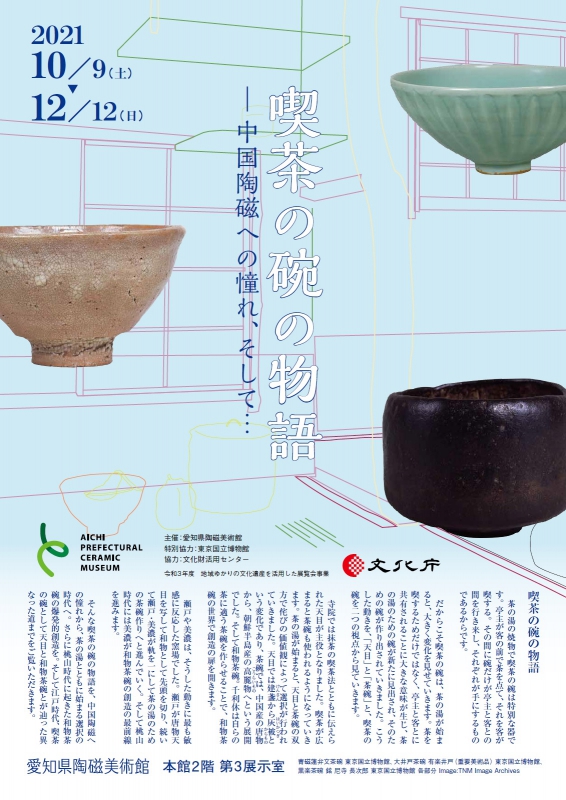
| Period | October 9, 2021 (Sat) - December 12, 2021 (Sun) |
|---|---|
| Place | Exhibition Room 3, Aichi Prefectural Ceramic Museum (held within the permanent exhibition “Ceramic Masterpieces of Japan, Asia, America and Europe”) |
| Opening Hours | 9:30 a.m. to 4:30 p.m. (Last admission at 4:00 p.m.) *On Saturday, October 9, the concurrently held special exhibition “Hana*Hana” will open at 11:00 a.m. following an opening ceremony. This feature exhibition will open normally at 9:30 a.m. |
| Closed | Mondays |
| Admission | Permanent and thematic exhibitions Adults: 400 yen; university and high school students: 300 yen; free admission for junior high school students and younger *Separate admission fee required for temporary and special exhibitions |
| Organizer | Aichi Prefectural Ceramic Museum |
| With Special Cooperation from | Tokyo National Museum |
| With Cooperation from | National Center for the Promotion of Cultural Properties |
| With Aid from | FY2021 Program to Support Exhibitions Utilizing Local Cultural Resources |
| Inquiries | Curator’s Office, Aichi Prefectural Ceramic Museum 234 Minamiyamaguchicho, Seto, Aichi 489-0965 TEL: 0561-84-7474 FAX: 0561-84-4932 |
| Website | Aichi Prefectural Ceramic Museum https://www.pref.aichi.jp/touji/index.html |
through the Kamakura, Muromachi, Momoyama, and Edo periods
Exhibition Highlights
The method of drinking matcha green tea was brought over from China by Zen Buddhist monks during the Heian period (794–1185). The tea ceremony began with karamono (Chinese-made) tea-drinking bowls, but eventually new tea-drinking bowls were born in the form of koraimono (Korean-made) and wamono (Japanese-made) bowls. Karamono bowls possessed absolute beauty, while Goryeo-dynasty and “ash-dusted” glazed tenmoku tea bowls were discovered through the aesthetics of rustic simplicity and austere refinement (wabi). Later, during the Momoyama period (1573–1603 ), unique bowls were created according to Japanese aesthetics.
The Seto kilns, the only producers of glazed ceramics in medieval Japan, began creating wamono tea bowls modeled after karamono bowls during the fourteenth century. The Seto and Mino kilns produced wamono bowls that approached karamono and later produced bowls suited to the wabi style with the flourishing of the tea ceremony. During the Momoyama period, the Mino kilns took the world by storm with distinctive styles such as Shino and Oribe wares.
This exhibition showcases such dynamic developments in tea-drinking bowls including tenmoku bowls, along with developments in tea-drinking bowls produced by wamono tea bowls as represented by Seto and Mino wares.
It presents nineteen works including nine from the collection of the Tokyo National Museum, such as “Tea Bowl, Named ‘Uraku Ido’” (Important Art Object).
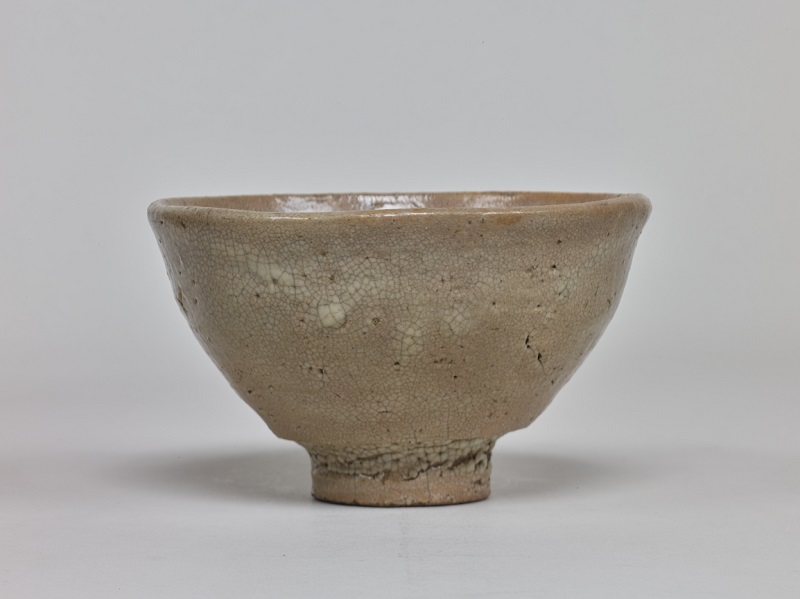
Tea Bowl, Named “Uraku Ido”(Important Art Object)
Korea 16th century Tokyo National Museum
Distinguished by its soft, slightly reddish orange color, this bowl was used by famous masters of the tea ceremony such as Urakusai. *On display from Tuesday, October 19
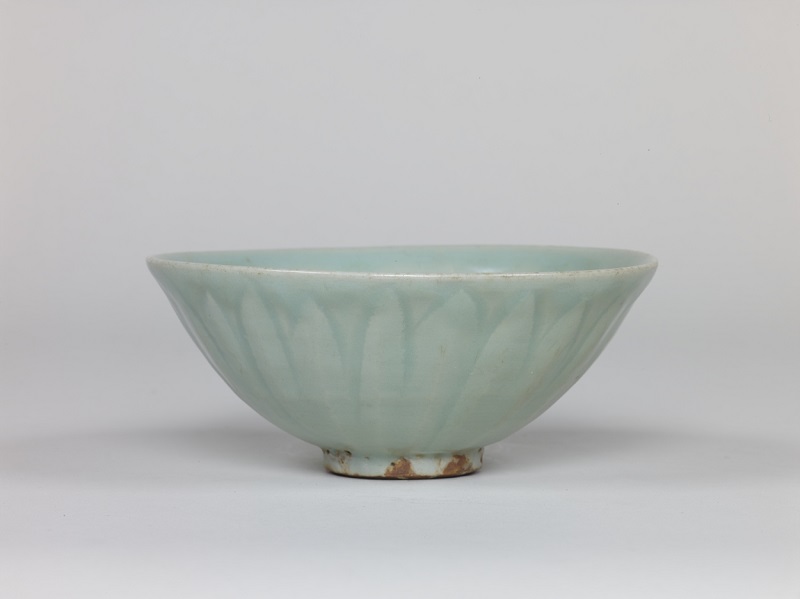
Bowl, Celadon Glaze with Carved Lotus Petals
Longquan kilns, China 15th century Tokyo National Museum
Japanese tea-ceremony practitioners saw perfect beauty in this acclaimed celadon bowl decorated with delicate lotus petals.
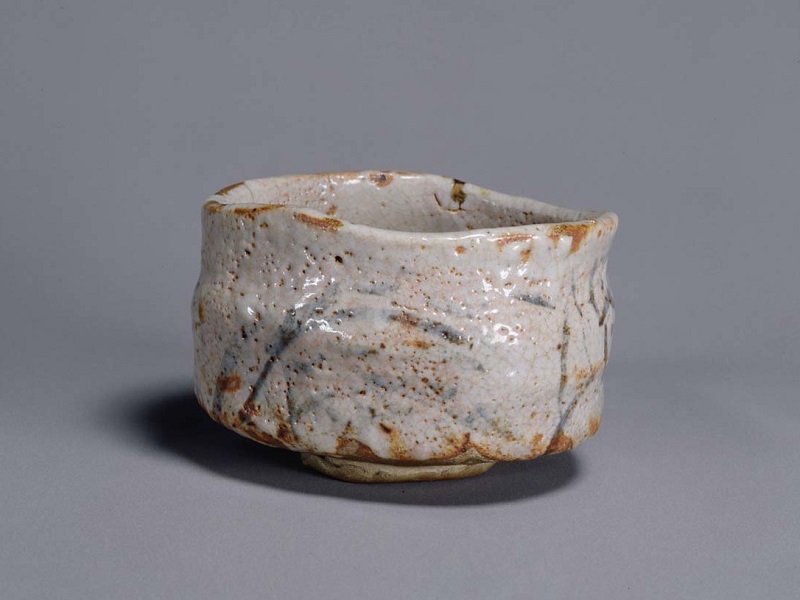
Tea Bowl, Named “Furisode (Swinging Sleeves)”
Mino (Gifu Prefecture) 16th–17th century Tokyo National Museum
A design of pampas grass is faintly visible through the white glaze in this fine example of the beauty of Shino ware.
Interactive Digital Content
“A Hands-On Look at Legendary Tea Bowls,” interactive content for appreciating cultural properties in new ways developed using 8K technology, can now be experienced at the Aichi Prefectural Ceramic Museum.
By moving tea-bowl-shaped hands-on controllers created to look and weight the same as the original cultural properties, users can view high-resolution images on an 8K monitor from any angle. Choose your favorites from among six legendary tea bowls and enjoy touching them and turning them in your hands.
You can view the originals of “Tea Bowl, Named ‘Uraku Ido’” (Important Art Object) and “Tea Bowl, Named ‘Furisode (Swinging Sleeves)’” featured in this content by visiting “The Story of Tea-Drinking Bowls: Admiration of Chinese Ceramics and Beyond.”
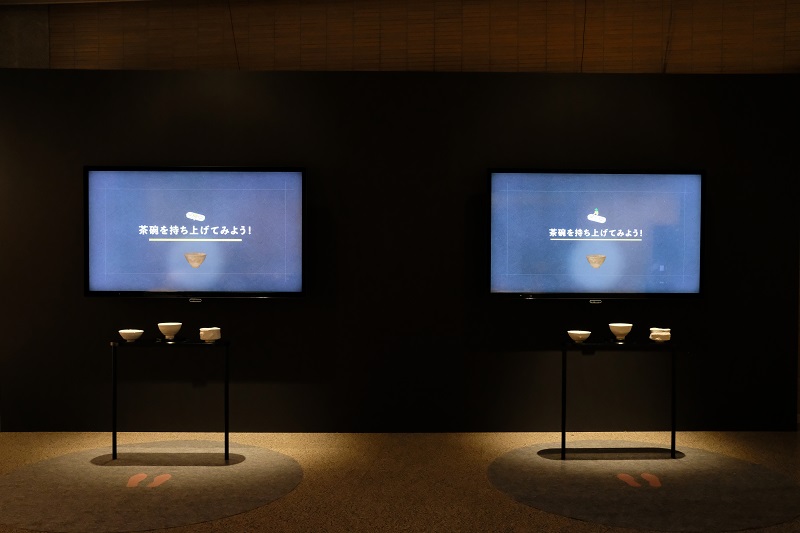
The demonstration experiment at the Tokyo National Museum (November 2020)
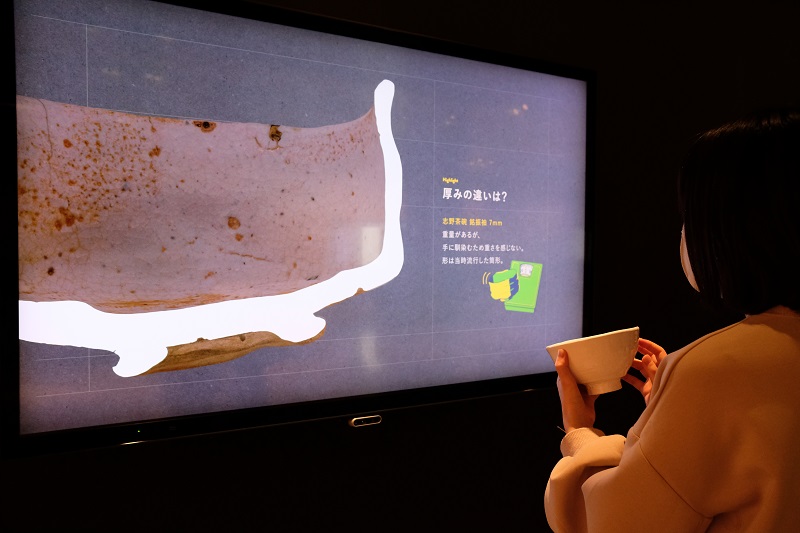
The tea bowl on the screen moves with the hands-on controller held by the user.

